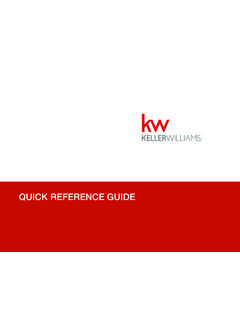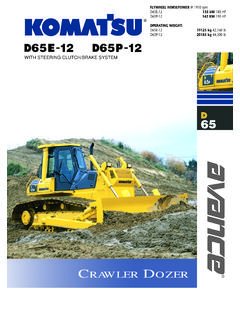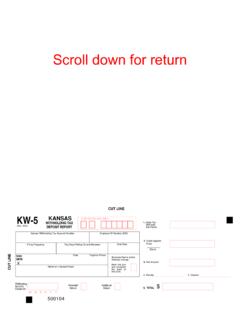Transcription of 12d V9 Drainage Analysis Ku Kw - Civil Engineering
1 12d ModelCivil and Surveying SoftwareDrainage Analysis ModuleKu & Kw CalculationOwen Thornton BE (Mech), 12d Model April 2006 Revised:19 June 200710 September 200728 April 2008 (V8C1p)16 October 2008 (V9C1a)This document describes the procedures for calculatingKu and Kw coefficients, as implemented in theDrainage Analysis module of 12d stormwater pits, maintenance holes and culvert inlets:Ku coefficients apply to pressure head (Hp) stormwater pits and maintenance holes:Kw coefficients apply to water surface elevation (WSE) 1 of 2112d Model - Drainage Analysis Module - Ku & KwIntroductionFor the design of piped stormwater systems, the loss (or gain) in pressure head ( Hp) through a pit1, is typically assumed proportional to the velocity head at the entrance of the downstream pipe. Likewise proportional, but sometimes of different magnitude, is the corresponding change in effective water surface elevation ( WSE) between the pit and the downstream pipe.
2 However simple this may seem, the two coefficients of proportionality (denoted by Ku for pressure head changes, and Kw for WSE changes) are generally dependent on so many different factors, that their adequate estimation still relies largely on the results of empirical study. Perhaps the most thorough sources emanating from such study, are the so called "Missouri Charts" (Sangster et al, 1958) and "Hare Charts" (Hare, 1981). The Australian Rainfall and Runoff (ARR, 1987), suggests the use of these sets of charts, in preference to any other originally published, the charts are highly complex, varied in presentation, and somewhat open to interpretation reflective of the chaotic nature of flow through pits. A good deal of judgement is required in selecting the appropriate chart to use for a particular pit configuration, and in most cases, iterative calculations are required.
3 For large stormwater networks, this typically leads to a huge time-cost for the designers, or alternatively, to an overly-conservative design approach. To overcome such problems, several semi-analytical methods have been proposed, with an aim to replace the dependence on charts. These range from the relatively simple methods suggested by Argue (1986), Hare et al (1990)2, and Mills et al (1998), to the more accurate methods (which are arguably as complex as using the charts manually) suggested by Parsell (1992), and Stein et al (1999). A summary paper (O Loughlin et al, 2002) reviewed the latter four of these methods, and concluded that none matched acceptably well, across the full range of pit configurations covered by the charts, and that more work was required to develop a practical method suitable for implementation with a Model adopts a method that is purely numerical, rather than semi-analytical.
4 It is based on the fact that the majority of the chart data ( the charts for pits with no more than a single upstream pipe) offer a range suitable for consideration in a continuous sense. This fact has allowed the chart data to be re-arranged and combined into a single database of Ku and Kw values one that both spreads evenly across the full range of the charts used, and is convenient for computation. The resultant database is used to calculate values which match the charts perfectly, for those pits which coincide with one of the discrete chart configurations; otherwise, values are calculated which indicate a linear transition between particular charts. The Ku and Kw calculations are all based on a robust, programmed sequence of one-dimensional and/or three-dimensional interpolations within the method may be thought of as a particular, holistic way of interpreting the chart data.
5 It has been developed with an aim to minimise user input, and increase the overall efficiency of the design process. Individual charts do not need to be nominated at each pit, and horizontal and vertical misalignment of pipes (a key factor affecting Ku and Kw) is considered with minimal interaction. The method is most reliable for pits with either no upstream pipe, or one upstream pipe. For pits with two or more upstream pipes (for which very few discrete charts exist) a single equivalent upstream pipe is determined, yielding results which compare adequately with the limited chart data culvert inlets, 12d Model adopts a different method, based on data published by the Federal Highway Administration (HDS5, 2005), to calculate Ku values for culverts flowing under inlet or outlet control. This method is detailed on page 19, and covers a wide range of different culvert The term "pit" is extended in meaning here, to include maintenance holes (where no grate inlet flow from above is possible).
6 2 Sometimes referred to as the "Hare Equations". These equations differ from the "Hare Charts", in that they offer only an approximation to the preferred configuration charts (see configurations: G1, T1, T2, T4, T8, T10).Page 2 of 2112d Model - Drainage Analysis Module - Ku & KwKu & Kw Calculations in 12d Model12d Controls 12d SettingsRemarksKu methodDirectKu & Kw specified directly by ,Kw via ChartsKu & Kw via chart ,Kw>0 via Charts Prevents -ve Ku or Kw from culvert methodsSee Culvert Inlets on page configPreferredGives lowest Ku & Kw (on average).Good:Fair:PoorGives highest Ku & Kw (on average).Independent Chart Variables : g =angle between grate flow line and d/s pipe u = angle between equivalent u/s pipe and d/s pipeQg/Qo =equivalent grate flow ratioDu/Do =equivalent pipe diameter ratioS/Do =submergence ratioProcedural Steps :1A) Grate Pit chart is used for pits where Qg/Qo = G1 used where g <= 15 ; G2 used where g > 15.
7 1B) Through Pit charts are used for pits where <= Qg/Qo <= Interpolation within a Through Pit chart is based on Qg/Qo and Du/Do. Interpolation between Through Pit charts is based on u and Ku config: Preferred, Good, Fair, 45 90 PreferredT1T2T4T8T10 GoodT1T2T5T8T10 FairT1T3T6T9T10 PoorT1T3T7T9T101C) For pits where < Qg/Qo < , a further (linear) interpolation based on Qg/Qo is made, between the interpolated data from steps 1A and Source 1: QUDM (1994).12d Pit Config G1 G2 T1 T2 T3 T4 T5 T6 T7 T8 T9 T10 Chart Source 2:ACTDS (2003).QUDM Ku Chart # 3232333435373738404244462 ) Step 1A, 1B or 1C produces a Ku and a Kw curve (both versus S/Do).QUDM Kw Chart # 323233343637373941434547 Actual S/Do values are calculated to intersect the Kw curve, and thusIn both source documents:ACTDS Ku Chart # 1121314109161820227 find the applicable S/Do for the final Kw & Ku values.
8 Chart for Grate Pits from Sangster et al (1958).ACTDS Kw Chart # 1121315109171921238 Charts for Through Pits from Hare (1981).ACTDS Pit Type # 123111287131415166 Page 3 of 2112d Model - Drainage Analysis Module - Ku & KwHow does 12d Model determine the Ku & Kw chart inputs: Qg/Qo, Du/Do, g, u?Example with grate flow and 3 u/s pipes:Qg/Qoequivalent grate flow ratio( Steps: 1A, 1B, 1C )FromRescaled + = (Qg)eq / = = <= Qg/Qo <= pipe diameter ratio( Steps: 1B, 1C )Pipe DiametersPipe = SQR(Au/Ao) =SQR(.221/.283) = <= Du/Do <= gangle between grate flow line and d/s pipe( Steps: 1A, 1C )Angle between setout string and d/s pipe g = <= g <= 90 uangle between equivalent u/s pipe and d/s pipe( Steps: 1B, 1C )*VAF = Vertical Alignment Factor = ( Do - Drop ) / DuHoriz Drop VAF* u = VAF < + ( excessive vertical misalignment),Qu1-> u = ( ) + + is increased linearly to compensate, viz:Qu2-> ( ) + + + > VAF > > ( ) = <= u <= 90 Horiz < < 90 Page 4 of 2112d Model - Drainage Analysis Module - Ku & KwGrate Pits ( grate flow only)Example of Kw calculation (Ku = Kw) :INPUTC hart : G1G2(G2) g0 90 (>15 ) used where g <= 15 used where g > 15 (as per Chart 32 of QUDM, 1994) WSE = WSE - HGLo = = + HGLoAnswer: Kw = Ku =.
9 S/Do = ChartG2 ChartG2 IntersectionPage 5 of 2112d Model - Drainage Analysis Module - Ku & KwThrough Pits ( through flow and grate flow)Example of Ku & Kw calculation :INPUTC hart :T3T3T3T3T7T7T7T73-d interpolation factors - a = ( u - ) / ( - ) - * b = (N - ) / ( - ) - c = (Du/Do - ) / ( - )Ku configPoorGeneral 3-d interpolation Kw2 Kw3 Kw4 Kw5 Kw6 Kw7 =(1-a) (1-b) (1-c) K1 + (1-a) (1-b) c +(1-a) b (1-c) K3 +(1-a) b c +a (1-b) (1-c) K5 +a (1-b) c +a b (1-c) K7 +a b c * Non-linear interpolation, as per QUDM (1994). N = ( - [Qg/Qo]2 )S/DoKu1 Ku2 Ku3 Ku4 Ku5 Ku6 Ku7 WSE = WSE - HGLo = Hp = HGLu - HGLo = : Kw = .. Ku = .. S/Do = Chart InterpolationKu Chart InterpolationKw IntersectionPage 6 of 21Ku Charts for Through Pits12d Model - Drainage Analysis Module - Ku & KwQg/Qo = & Du/Do = = & Du/Do = 7 of 21Ku Charts for Through Pits12d Model - Drainage Analysis Module - Ku & KwQg/Qo = & Du/Do = = & Du/Do = 8 of 21Ku Charts for Through Pits12d Model - Drainage Analysis Module - Ku & KwQg/Qo = & Du/Do = = & Du/Do = 9 of 21Ku Charts for Through Pits12d Model - Drainage Analysis Module - Ku & KwQg/Qo = & Du/Do = = & Du/Do = 10 of 21Ku Charts for Through Pits12d Model - Drainage Analysis Module - Ku & KwQg/Qo = & Du/Do = = & Du/Do = 11 of 21Kw Charts for Through Pits12d Model - Drainage Analysis Module - Ku & KwQg/Qo = & Du/Do = = & Du/Do = 12 of 21Kw Charts for Through Pits12d Model - Drainage Analysis
10 Module - Ku & KwQg/Qo = & Du/Do = = & Du/Do = 13 of 21Kw Charts for Through Pits12d Model - Drainage Analysis Module - Ku & KwQg/Qo = & Du/Do = = & Du/Do = 14 of 21Kw Charts for Through Pits12d Model - Drainage Analysis Module - Ku & KwQg/Qo = & Du/Do = = & Du/Do = 15 of 21Kw Charts for Through Pits12d Model - Drainage Analysis Module - Ku & KwQg/Qo = & Du/Do = = & Du/Do = 16 of 2112d Model - Drainage Analysis Module - Ku & KwOther Chart DataNotes :The Missouri Chart used by 12d Model for Grate Pits, possibly suggests conservatively high Kw values at low submergence ratios, compared with the evidence suggested by some other empirical and analytical studies. However, due to the typically low velocity head in the downstream pipe, a high Kw value rarely makes a significant difference in Grate Config M1M2M3M4 QUDM Ku Chart # 4852, 534949 QUDM Kw Chart # 4852, 534949 ACTDS Ku Chart # 34, 5, 61112 ACTDS Kw Chart # 35, 61112 ACTDS Pit Type # 45910 For other configurations of multiple upstream pipes especially those where the jet of each upstream pipe projects wholly into the downstream pipe Ku config settings of "Preferred" or "Good", may be more source documents contain other charts not used by 12d Model, covering the following limited set of four pit configurations, each with two upstream pipes:The Hare Charts used by 12d Model for Through Pits, are all based on square pits with sides twice the diameter of the downstream pipe.






